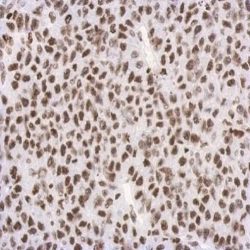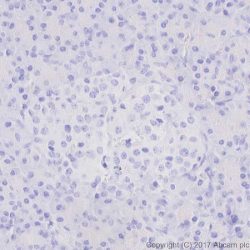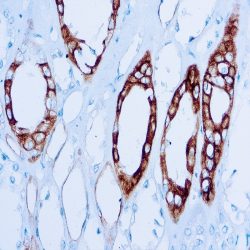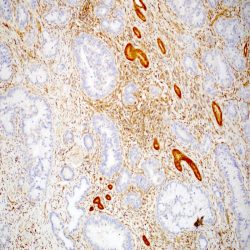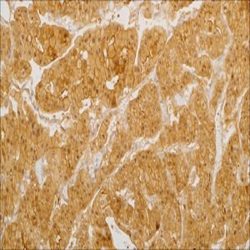مونوکلونال
نمایش 281–285 از 285 نتیجه
فیلتر ها-
آنتی بادیهای ایمونوهیستوشیمی
آنتی بادی – H3K27me3 (Lys27) (clone C36B11)
امتیاز 0 از 5اطلاعات بیشترName: Rabbit Anti-Human H3K27me3 (Lys27) Monoclonal Antibody (Clone C36B11)
Description and aplications: The nucleosome, which consists of four core histone proteins (H2A, H2B, H3 and H4), is the main component of chromatin. Originally thought to function as a static scaffold for DNA packaging, histones have subsequently been shown to be dynamic proteins, undergoing multiple types of posttranslational modifications, including acetylation, phosphorylation, methylation, and ubiquitination. Histone methylation is a fundamental determinant for
the formation of active and inactive regions of the genome and is crucial for their proper programming during embryonic development. Arginine methylation of histones H3 (Arg2, 17, 26) and H4 (Arg3) promotes transcriptional activation and is mediated by a family of arginine methyltransferase (PRMT)-like proteins, including the coactivators PRMT1 and CARM1(PRMT4). In contrast, a more diverse set of lysine methyltransferase-type histones has been identified, among which all but one contains a conserved catalytic SET domain, and that was originally identified in the Zeste and Trithorax regulatory proteins of the fly Drosophila Su (var) 3-9. Lysine methylation occurs primarily at histones H3 (Lys4, 9, 27, 36, 79) and H4 (Lys20) and has been implicated in both transcriptional activation and gene silencing. Additionally, methylation of these lysine residues coordinates the recruitment of chromatinmodifyinenzymes containing methyl lysine binding modules, either as chromodomains (HP1, PRC1), PHD fingers (BPTF, ING2), Tudor domains (53BP1) and WD-40 domains (WDR5). Finally, the discovery of histone demethylases such as PADI4, LSD1, JMJD1, JMJD2 and JHDM1 has demonstrated that methylation is a reversible epigenetic marker. NF1 mutations and inactivation of CDKN2A are found
in most malignant peripheral nerve sheath tumors (TMVNP), where inactivation of CDKN2A is an early event during their development, occurring in the course of progression from conventional to atypical neurofibroma. Furthermore, inactivation of the polycomb repressive complex 2 (PRC2) resulting from mutually exclusive mutations of its SUZ12 or
EED1 portions has recently been identified in 70-90% of TMVNPs. In this regard, inactivation of PRC2 leads to loss of trimethylation at histone H3 lysine 27 (H3K27me3).Composition: Anti-human H3K27me3 (Lys27) rabbit polyclonal antibody obtained from ascitic fluid and prepared in 10mM PBS, pH 7.4, with 0.2% BSA and 0.09% sodium azide.
Immunogen: Synthetic peptide corresponding to the terminal amino acids of human histone 3 in which Lys27 is trimethylated.
-
آنتی بادیهای ایمونوهیستوشیمی
آنتی بادی PRAME 1 (EPR20330)
امتیاز 0 از 5اطلاعات بیشترName: Rabbit Anti-Human PRAME 1 Monoclonal Antibody (Clone EPR20330)
Description and aplications: The PReferentially expressed Antigen in MElanoma (PRAME), or LB33-E antigen, is part of the family of melanoma nuclear proteins recognized by cytolytic T lymphocytes and is encoded by a gene of the same
name (PRAME) located on chromosomal region 22q11.22. The PRAME protein has been characterized as a dominant inhibitor of the retinoic acid receptor, thus participating in the blockade of cell proliferation, differentiation or apoptosis induced by retinoic acid through the RARA, RARB and RARG receptors. Thus, overexpression of PRAME in tumor cells confers a survival advantage over normal cells. In melanomas, PRAME inhibition restores retinoic acid signaling an reinstates the sensitivity of tumor cells to the antiproliferative effects of this molecule.Composition: Anti-human PRAME 1 rabbit monoclonal antibody obtained from ascitic and prepared in 10mM PBS, pH 7.4, with 0.2% BSA and 0.09% sodium azide.
Immunogen: N/A
-
آنتی بادیهای ایمونوهیستوشیمی
آنتی بادی Renal cell carcinoma marker (PN-15)
امتیاز 0 از 5اطلاعات بیشترName: Mouse anti- Human Renal cell carcinoma marker (PN-15) Monoclonal Antibody
Description and aplications:This antibody detects the membrane glycoprotein gp200. In a normal kidney, gp200 is located along the brush border of the contoured and straight segments of the proximal tubule, as well as focally along the luminal surface of Bowman’s capsule, contiguous with the exit of the proximal tubule. Gp200 is also located on the luminal surface of the mammary ducts and lobes and the tubular epithelium of the epididymis, in the cytoplasm of parathyroid and parenchymal cells, and focally within the colloid of thyroid follicles.
Composition: Anti-human renal cell carcinoma marker (PN-15) mouse monoclonal antibody purified and prepared in 10mM PBS, pH 7.4, with 0.2% BSA and 0.09% sodium azide.
Immunogen: Microsomal fraction of human renal cortical tissue homogenate.
-
آنتی بادیهای ایمونوهیستوشیمی
آنتی بادی SMAD4/Dpc4 (B8)
امتیاز 0 از 5اطلاعات بیشترName: Mouse Anti-Human SMAD4/Dpc4 Monoclonal Antibody (Clone B8)
Description and applications: The Mothers Against Decapentaplegic homolog 4(SMAD4) protein, also known as MADH4, MANrelatedprotein 4, MAD, pancreatic carcinoma deletion factor 4 or DPC4, is linked to the SMAD4 suppressor gene, which consists of 11 exons, and is located in the genomic region 18q21.1. This gene shows allelic or biallelic loss in 50% of pancreatic carcinomas
Composition: Anti-human SMAD4/Dpc4 mouse monoclonal antibody obtained from ascitic fluid and prepared in 10mM PBS, pH 7.4, with 0.2% BSA and 0.09% sodium azide
Immunogen: N/A -
آنتی بادیهای ایمونوهیستوشیمی
آنتی بادی Parvalbumin (EP300)
امتیاز 0 از 5اطلاعات بیشترNAME: Rabitt anti-Parvalbumin Antibody (Clon EP300)
Description and applications: Parvalbumin is a protein with wide calcium-ionbinding affinity and thus intervenes in its cytosolic homeostasis. The PVALB gene, which encodes the production of this protein, is located in the chromosome region 22q12.3 and shows structural and functional similarities with the one of the Calmodulin and Troponin C, whose coding genes constitute a superfamily.
Composition: anti-human Parvalbumin rabbit monoclonal antibody purified from serum and prepared in 10mM PBS, pH 7.4, with 0.2% BSA and 0.09% sodium azide

